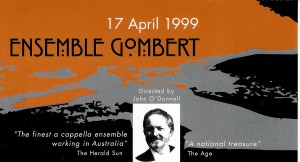Tuesday 9 June 1998
Xavier College Chapel, Barkers Rd, Kew
Subscription Concert 3
PROGRAM
Guillaume Dufay(c. 1400-1474)
Nuper rosarum flores
Mirandas parit haec urbs florentina
Salve flos Tuscae gentis Florentia
Heinrich Isaac (c. 1450-1517)
Quis dabit capito meo aquam?
Missa Salva nos
Philippe Verdelot (c. 1470/80-c. 1530/40)
Laetamini in Domino
Congregati sunt
Recordare, Domine
In te, Domine, speravi
Alessandro Striggio (1535-1592) Ecce beatam lucem a 40
SINGERS
Soprano
Deborah Summerbell
Carol Veldhoven
Maria Pisani
Helen Gagliano |
Alto
Bernadette Ballard
Jennifer Mathers
Margaret Arnold
Barbara Tattam |
Tenor
Frank Prain
Peter Neustupny
Phillip Legge
Stuart Tennant |
Bass
Philip Nicholls
Tom Henry
Thomas Drent
Jerzy Kozlowski |
Additional singers for the Striggio:
Soprano: Nina Pereira, Sally Watt, Jane Phillips, Claerwen Jones, Margaret Pearce
Alto: Niki Ebacioni, Helena Simpson, Fiona Furphy, Christopher Field
Tenor: Joel Gladman, Vaughan McAlley, Matthew Flood, Paul Norbury, Ben Owen, Simon Biazeck,
Bass: John Weretka, Richard Pyros, Johnathan Wallis, Adrian Barrett, Sam Furphy, Julian Liberto, Alexander Macrae, Charles Pinkham
REVIEWS
Tuesday 16 June 1998, The Age [Melbourne], page 18.
The joys of travel
Joel Crotty
Cultural tourism has become big business in Australia. Tour operators are developing packages for people
with large disposable incomes to travel to the Old World’s opera houses and concert halls and hear music by
the great masters.
A far cheaper, though no less a rewarding, experience has been Ensemble Gombert’s current season under the
umbrella title of An Italian Year. So far, we have explored the Renaissance courts of Venosa, via the music of
Gesualdo, and Ferrera, with reference to scores primarily by Josquin Desprez.
At Tuesday’s concert, we travelled to Florence and witnessed the grand style of Dufay, Isaac, Verdelot and
Alessandro Striggio. The brief trip through 125 years of Florentine musical history was vivid.
The concert opened and closed with what could be termed architectural music, but from vastly different
approaches. In musicological circles, Dufay’s Nuper rosarum flores is probably one of the most discussed
works from the Renaissance. With incredible imagination, the composer conceived a score based on
isorhythmic proportions that corresponded precisely to the structure of the cathedral, Santa Maria del Fiore.
The choir produced a rich sound that belied, at every level, the score’s mathematical formulations.
At the other end of the evening was Alessandro Striggio’s Ecco beatum lucem for 40 parts. As the ensemble’s
artistic director John O’Donnell points out in the notes, there are only a couple of extant scores from the
Renaissance encompassing such mammoth sonic mapping. The 16 voices of Gombert were joined by a
further 24 choristers, forming a large circle in keeping with the original performance practice for this piece.
Parading in this manner forces the sound inwards, then up and out. The clarity is thus less discernible from
the outside and mistakes easier to conceal. While a few dubious happenings were clearly evident, the
performers, on the whole, maintained a cohesion that, under the circumstances of numerous independent
lines, was commendable. O’Donnell was obviously happy with the rendition, for he rotated the singers 180
degrees and gave us a repeat performance. Striggio’s spectacle was an interesting aside, but hardly great
music. None the less, this compositional byway would rarely receive an airing here if not for Ensemble
Gombert.
More important to the quality (as opposed to the quantity) of the concert was Isaacs’ Quis dabit capito meo
aquam? and Missa La Spagna. These works highlighted Isaac’s masterly understanding of word-painting and
contrapuntal layering.
In Quis dabit, written as a lament on the death of Lorenzo de Medici, the choir was able to transmit all the
emotional content with a deft sensibility. The same level of exquisite attention to detail was not always
forthcoming in the mass.
However, for the most part, they presented the work with refined balance and beautifully clear phrasing,
particularly in the compact Credo. Unlike most cultural tourists, we left the site not with photographs, but
with snatches of music we will periodically recall until the ensemble’s Italian expedition recommences in
November.
Joel Crotty/Courtesy of The Age
Friday 12 June 1998, The Herald Sun [Melbourne], page 86.
Past is given voice
Xenai Hanusiak
THE Melbourne musical community is fortunate to have a music scholar of the calibre of John O’Donnell.
His chamber choir, the Ensemble Gombert, represents the results of his considerable and dedicated
musicological qualifications.
The ensemble specialises in authentic performance practice, in particular the music of the Renaissance and
early baroque.
The third concert of the 1998 subscription series, An Italian Year, focused on music composed for Florence.
In this very satisfying program we heard secular and religious works by the Frenchman Dufay, two
Netherlanders, Isaac and Verdelot, and the lesser known Italian composer Striggio.
In all offerings the Ensemble Gombert expertly performed the works with the stylistic accuracy we have
come to expect.
In a set of Dufay motets the flowing, song-like quality was evident.
Furthermore, there remained throughout a seamlessness in timbre.
The leading voice was supported by the two supporting instrumental voices with controlling influence.
In Missa salva nos by Heinrich Isaac, the choir brought out the harmonic richness of the score and maintained
a rhythmic verve.
Each inner section of the Ensemble Gombert is beginning to develop a distinctive quality: the sopranos
remain sweet and lucid, bringing an almost childlike quality to the ensemble, the altos caress the note with a
consistently musical approach, and the basses underpin the ensemble with a similar warmth.
The tenors, who in the present line-up possibly represent the youngest members, produce a reedy quality.
As a special treat, the Ensemble Gombert was joined by 24 extra singers to perform the rarely heard Ecce
beatam lucem by Striggio, scored for 40 vocal lines. The enlarged ensemble sang the work in a full circle.
The piece was received with so much enthusiasm it was performed twice.
It was refreshing to watch the young recruits sing with so much obvious excitement.
It is also satisfying to know they have a choir such as the Ensemble Gombert to aspire to.

